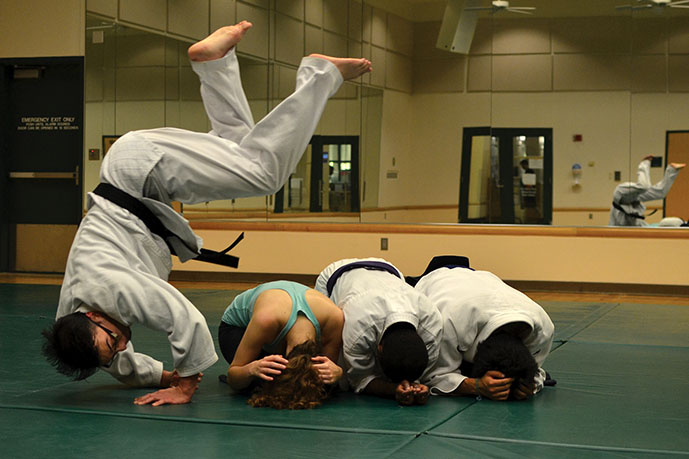

Every Sunday, Monday and Wednesday at the Wellness Center, students in the Aikido Club throw and pin each other – but the ultimate goal is not to harm anyone at all.
Members of the club – which began at UM 26 years ago – practice the Japanese martial art, founded by Morihei Ueshiba, that teaches practitioners to solve conflicts with minimal damage inflicted upon all parties involved.
“The main idea of aikido as we teach it is that it’s not just a martial art, it’s a method of conflict resolution that can be applied to life as a whole,” said Ben Sager, club president. “Unlike most martial arts, the goal isn’t to defeat your opponent so much as it is to end the conflict with the least resistance and least damage to the other person.”
In the interest of injury-free conflict resolution, aikido teaches students to flow with an opponent’s natural momentum. In fact, it does not involve any punches or kicks.
“To get opponents off balance, we generally move with their motion and when it reaches us, they have overextended just enough to turn them in other ways,” Sager said. “This relates [to an argument]: You are taking the energy given to you, moving against it briefly with your own energy and ideas, then turning in the direction the body naturally goes, and ideally sending them on their way with the experience and energy you gave them to consider.”
In many forms of physical combat, such as boxing and mixed martial arts, the object is to bloody and knock out an opponent. But in aikido, the goal is to pin an adversary to the ground in the most pain-free way possible. The Aikido Club’s four guiding principles are non-resistance, non-effort, gentleness and reconciliation.
“Non-effort and non-resistance don’t necessarily mean no effort and no resistance,” Aikido Club’s head instructor Roger Sierra said. “They’re talking about redirecting tension, staying calm and not expending too much energy.”
“Gentleness is about causing as little physical damage to an opponent as possible in a given situation, and reconciliation is about focusing on getting to a group consensus where everyone can be happy and safe,” he added.
In aikido class, which usually draws about 10 students, Sierra stresses the principle behind the unique style of martial art – nonviolent conflict reconciliation – rather than endlessly drilling students on technique.
“I like to focus on the self-improvement aspect of martial arts rather than on technical perfection,” Sierra said. “We don’t train each and every technique. It’s the concepts behind the techniques that are important.”
Aikido is equal parts self-defense and philosophy. It teaches practitioners to fight opponents with respect rather than with spite, and its guiding principles are abundantly useful in everyday life. Just ask Sara Linker, a club member who has been practicing aikido for four years.
“Aikido has given me analogies with which to look at my daily life,” Linker said. “It’s taught me how to deal well with bosses and how to deal with people in general. Because of aikido, I feel confident in figuring out how to solve and approach conflicts.”
For More information
Aikido Club dues are $40 per semester or $70 per year. For more information on joining, email Sager at b.sager@umiami.edu or Sierra at r.sierra@umiami.edu.






